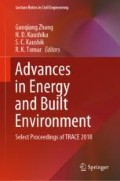Abstract
Among renewable sources of energy, wind energy sources (WES) are the most demanded globally. Wind energy systems are usually facilitated with fixed velocity type induction machines that provide comparable lesser costly options for power generation. Although these asynchronous generators are used to consume reactive power, having numerous advantages over synchronous machines make them so popular. The shunt capacitors can be used to generate this consumable reactive power, but usually, these circuitries do not yield desired results during the contingencies or turbulent behavior of the system. Therefore, effective and continuous solutions such as flexible alternating current transmission systems (FACTS) are compulsory in such cases. In the presented paper, the stabilization of the voltage stability indices of energy system during the turbulent behavior of the integrated WES-based energy systems using the static compensator (STATCOM) is investigated. Furthermore, the proportional–integral controller of the control system is tuned by an adaptive technique, i.e., adaptive neuro-fuzzy inference system (ANFIS). The considered WES generators are the squirrel cage induction generators (SCIG). Simulation studies are performed on the IEEE-9 bus test system. Obtained results prove that the SCIG with ANFIS tuned STATCOM improves the performance of the designed power network during the turbulence.
Access this chapter
Tax calculation will be finalised at checkout
Purchases are for personal use only
References
Aekcrmann T et al (2001) Distributed generation: a definition. Electr Power Syst Res 57:195–204
Ahilan T, Mohammed KP, Arumugham S (2009) A critical review of global wind power generation. Am J Appl Sci 6:204–213
Chaurasia GS, Singh AK, Agrawal S, Sharma NK (2017) A meta-heuristic firefly algorithm based smart control strategy and analysis of a grid connected hybrid photovoltaic/wind distributed generation system. Sol Energy 150:265–274
Chaurasia GS, Agrawal S, Sharma NK (2017) Comparative analysis of various MPPT-techniques for optimization of solar-PVEC system. Global J Enterprise Inf Syst 9(3):94–101
Al-Majed SI, Fujigaki T (2010) Wind power generation: an overview. In: Proceedings of the international symposium modern electric power systems (MEPS). IEEE Xplore Press, Wroclaw, Poland, 20–22 Sept 2010, pp 1–6
Kundur P (1994) Power system stability and control. McGraw-Hill, New York
Bansal RC, Bhatti TS, Kothari DP (2003) Automatic reactive power control of wind-diesel-micro hydro autonomous hybrid power systems using ANN tuned static VAR compensator. In: Proceedings of international conference on large engineering system conference on power engineering (LESCOPE), Montreal, Canada, 7–9 May 2003, pp 182–188
Gandhar S, Ohri J, Singh M (2014) Application of SSSC for compensation assessment of interconnected power system. In: 6th IEEE International conference on power electronics, NIT Kurukshetra, India, 8–10 Dec 2014
Grünbaum R (2010) FACTS for grid integration of wind power. In: Innovative smart grid technologies conference Europe), IEEEPES, 11–13 Oct 2010, pp 1–8
Madhavi Latha G, Kiranmayi R (2016) Transient stability improvement of hybrid power system by VR-FCL using PSO. Int J Sci Eng Technol Res (IJSETR) 5(11). ISSN: 2278–7798 (November)
Jang JSR (1993) ANFIS: adaptive-network-based fuzzy inference systems. IEEE Trans Power Syst 23(3):665–684
Ishibuchi H, Fujioka R, Tanaka H (1993) Neural networks that learn from fuzzy if-then rules. IEEE Trans Fuzzy Syst 1(2):85–97
Author information
Authors and Affiliations
Corresponding author
Editor information
Editors and Affiliations
Rights and permissions
Copyright information
© 2020 Springer Nature Singapore Pte Ltd.
About this paper
Cite this paper
Gandhar, A., Gupta, S., Gandhar, S. (2020). Improvement of Energy Efficiency of Isolated Wind Power System Based on Voltage Indices Using ANFIS Tuned STATCOM. In: Zhang, G., Kaushika, N., Kaushik, S., Tomar, R. (eds) Advances in Energy and Built Environment. Lecture Notes in Civil Engineering , vol 36. Springer, Singapore. https://doi.org/10.1007/978-981-13-7557-6_10
Download citation
DOI: https://doi.org/10.1007/978-981-13-7557-6_10
Published:
Publisher Name: Springer, Singapore
Print ISBN: 978-981-13-7556-9
Online ISBN: 978-981-13-7557-6
eBook Packages: EngineeringEngineering (R0)

